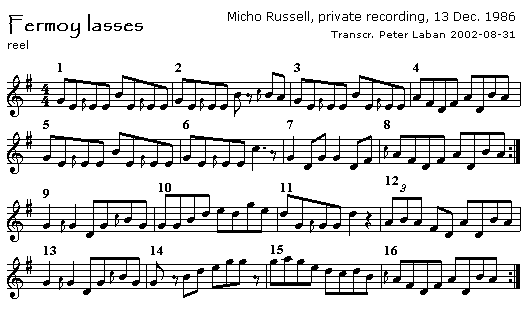A brief analysis by Peter Laban, 31 August 2002

The Fermoy lasses is a well-known reel, highly popular among Clare players of Micho's generation. Although the tune was published in O'Neill's, its popularity in Clare may be at least partly due to its having been played by travelling pipers Johnny and Felix Doran who started coming to Clare by the end of the 1930s. The tune (played as a duet with fiddle player John Kelly) is among the famous (and only) recording of Johnny's playing made at the Irish Folklore Commission in 1948. Several recordings of Felix playing the tune are in existence as well.
Two Clare pipers of Micho's generation, Willie Clancy and Martin Rochford, both played versions of the tune and both were heavily influenced by the style of the Dorans. It is likely that Micho knew these versions. In fact both Micho and his brother Gussie talked to me on several occasions about listening to the Dorans and the impression their music made on them. As we will see later, Micho's version shares at least one distinct feature with Felix' version. Whatever the way, it was a tune he often played, often on the flute. It can also be found on his CD The Man from Clare, paired with, as here, The reel with the birl.
Like other tunes from Micho's playing presented here this was taken from a recording I made on the 13th of December 1986. Micho played a few tunes on the flute, an E-flat flute (please note that, following the common practice, the tunes are notated as if played in concert pitch).
Micho's playing here has, as usual, a beautiful natural bounce to it, the music seems to come completely naturally to him and the first impression is that of simplicity and drive. Examining the music more closely a couple of features stand out, however: as in all his playing Micho's music is highly detailed, despite its deceptive simplicity. Notes are lengthened and shortened throughout to aid the clarity of the phrases and the seemingly random stops in mid-tune are in fact very effectively used to aid the rhythm while providing ample room for a quick intake of breath. Micho uses a quite a few inversions of the standard tune and there are a few characteristic rhythmic figures present in this version.
The first half of the first part, bars 1 and 2, are very much as can be expected, note Micho's ornamentation of the Es, the off-beat roll most players would use becomes two Es, the first one cut but Micho never used the tap to complete the roll. The phrase ends in middle of bar 2 on a characteristic Micho note followed by a distinct stop before embarking on the next phrase. The first half of the part ends as can be expected although the last part of bar 4, leading into the next phrase sees a characteristic inversion when after the final note of the previous phrase, the A the expected cBA becomes DBA quite an effective device.
The second half of the first part sets out without surprises only to reveal a surprise in its tail when Micho ends the phrase not on the common and thus expected B but on a distinct C natural. This is a feature that can also be found in Felix Doran's playing of the tune and it is not unlikely Micho that picked up this from Felix. While not included in the transcription it is worth listening to the sound clip to hear how Micho ends the final playing of the tune on a long C natural giving great lift to the change into the next tune. In the first playing, however, bar 7 sees a fine flourish leading up to the end of the part where the ~G3F GBdB of the standard versions is changed into a characteristic Micho Russell rhythmic figure: G DG G leading up to the same resolution of the phrase used in bar 4.
The second part or turn of the tune opens with another rhythmic device often found in Micho's playing, the two long Gs in bar 9, wit ha slight emphasis on the second, creating a nice skipping effect. Bar 10 sees a common but very effective inversion when efge become edge. Bar 11 has a nice touch ending on a distinct d followed by a big silence which is pleasantly broken by a free-flowing triplet on A. The tune then rolls towards its end using some of the above devices, touching once again on the c natural in bar 15.
Micho plays the tune a few times, each time slightly different before ending it on the big C described above, going into